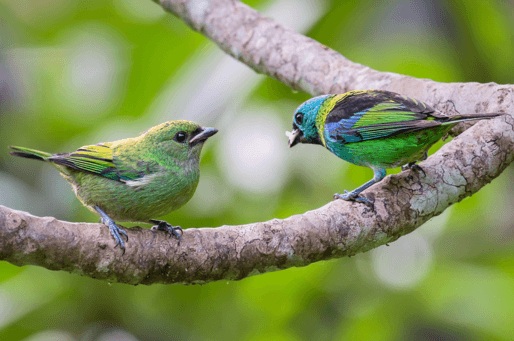ABC Birding: Serra Bonita Reserve, Brazil

Lay of the Land: The Serra Bonita Reserve conserves one of the largest remaining privately managed stretches of tropical Atlantic Forest in eastern Brazil. True to its name — meaning "beautiful mountain" in Portuguese — the reserve mostly consists of hilly submontane forests with some stretches of lowlands. The reserve is made up of private lands, many of them connected, including areas regenerating on former cacao farms. With support from various partners including ABC, Serra Bonita has grown from nothing when it was founded more than 25 years ago to more than 7,500 acres today. Of these, nearly 1,500 acres are being put into new, sustainable organic cacao production to help fund reserve operations. The reserve has ten staff, including four guards and a reserve manager; the cacao operation, called Agroflorestal Camacan, employs 22.

Focal Birds: More than 440 bird species have been recorded at Serra Bonita, including 70 Atlantic Forest endemics. These include the Critically Endangered Banded Cotinga, the Endangered Bahia Tyrannulet and Buff-throated Purpletuft, and these Vulnerable species: the White-eared (or Maroon-faced) Parakeet, Pink-legged Graveteiro, Plumbeous Antvireo, Salvadori's Antwren, and Buffy-fronted Seedeater. The reserve is also one of the few eastern Brazil locations where the Harpy Eagle (Vulnerable) still nests. Other notable birds found at Serra Bonita include the Black Jacobin (a hummingbird), Golden-capped Parakeet, Greater Crescent-chested Puffbird, Spot-billed Toucanet, White-wedged Piculet, Pin-tailed Manakin, Sharpbill, and Golden-chevroned, Green-headed, and Red-necked Tanagers.
Other Wildlife: Serra Bonita is a biodiversity and endemic-species hotspot. More than 1,000 vascular plant species have been recorded, as well as about 7,700 butterfly and moth species, and around 70 frog species. Mammals include the Critically Endangered Buff-headed Capuchin, Endangered Golden-headed Lion Tamarin, Wied's Marmoset (Vulnerable), Black-handed Titi monkey (Vulnerable), Southern Tiger Cat (Vulnerable), Margay (Near Threatened), Ocelot, Puma, Tayra, and Crab-eating Fox. Research is ongoing to inventory the area's wildlife. In recent years, reserve staff have been excited to find 20 new animal and 15 new plant species on site. Underscoring the need for the reserve and its sustained conservation, several species are now gone (extirpated) from the area, including the Northern Muriqui and Northern Brown Howler Monkey (both Critically Endangered) and the Jaguar (Near Threatened).

When to Visit: Rain falls for about half of the year at Serra Bonita. The dry season runs from October to March. Travel is often easiest then because rains only occur on occasion.
Conservation Activities: The reserve was established in 1997 when Brazilian lepidopterist Vitor Osmar Becker and University of Brasilia educator Clemira Souza began setting up a Private Natural Heritage Reserve on biologically diverse Atlantic Forest property they hoped to save from clearing. They also bought 1,500 standing trees, some centuries old, on land nearby, protecting them from timber harvesting. Within a few years, the couple purchased dozens of additional properties and added them to the expanding reserve. In 2001, the pair also teamed up with family and friends to establish the nonprofit Instituto Uiraçu. This organization enabled formal relationships and project support with universities and other research-based and conservation organizations.
Funds provided by ABC and other organizations support a variety of efforts to conserve this wildlife paradise into perpetuity. Among the efforts ABC supports: land acquisition (most recently, in 2022 ABC enabled the Instituto Uiraçu to protect 661 acres for the Banded Cotinga); training and equipment for fighting fires in and near the reserve; working with landowners and the local municipality to implement sustainable agroforestry and wastewater management techniques that prevent polluting the local watershed; and environmental education efforts, including school programs and the publication of bird and tree identification guides.
This year, ABC is supporting the reserve's efforts to survey and map the presence of three scarce species — the Banded Cotinga, White-eared Parakeet, and Channel-billed Toucan. The first two species are range-restricted and endemic to eastern Brazil; the Channel-billed Toucan population at Serra Bonita belongs to an isolated subspecies found only in southeastern Brazil. ABC thanks supporters who have made significant gifts in support of Serra Bonita, including Timothy Bradbury, Noel Mann, Sara Jane Oppenheim, Michael Reid, and Mary Ann Stehr.

Since the reserve's establishment, Harpy Eagles have returned. A nest was found there in 2018. Although the nest fell in 2020, Harpies have continued to be heard and seen. And in January 2024, biologists working with the Chico Mendes Institute for Biodiversity Conservation, while searching for a new nest, observed an adult and immature together within the reserve.
Directions: The easiest way to reach the reserve and its lodge is to fly to the coastal city of Ilhéus and then take a three-hour car ride. The reserve can help provide transport (see link below).
What to Do/Where to Stay: At the reserve, visitors can explore more than nine miles of trails and get a high-rise view from observation towers. Feeding stations attract parakeets, honeycreepers, tanagers, euphonias, and other birds. The reserve has an eight-room lodge, with four single and four double rooms. Meals are available. For reservations, email lodging@rsb.bio.



















































